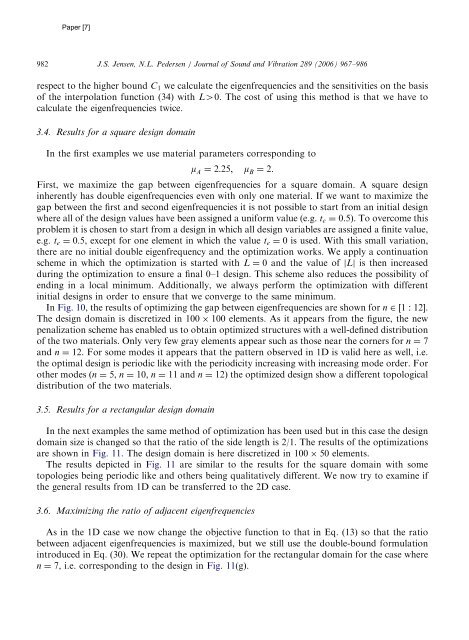WAVES AND VIBRATIONS IN INHOMOGENEOUS STRUCTURES ...
WAVES AND VIBRATIONS IN INHOMOGENEOUS STRUCTURES ...
WAVES AND VIBRATIONS IN INHOMOGENEOUS STRUCTURES ...
Create successful ePaper yourself
Turn your PDF publications into a flip-book with our unique Google optimized e-Paper software.
982<br />
respect to the higher bound C1 we calculate the eigenfrequencies and the sensitivities on the basis<br />
of the interpolation function (34) with L40. The cost of using this method is that we have to<br />
calculate the eigenfrequencies twice.<br />
3.4. Results for a square design domain<br />
In the first examples we use material parameters corresponding to<br />
mA ¼ 2:25; mB ¼ 2.<br />
First, we maximize the gap between eigenfrequencies for a square domain. A square design<br />
inherently has double eigenfrequencies even with only one material. If we want to maximize the<br />
gap between the first and second eigenfrequencies it is not possible to start from an initial design<br />
where all of the design values have been assigned a uniform value (e.g. te ¼ 0:5). To overcome this<br />
problem it is chosen to start from a design in which all design variables are assigned a finite value,<br />
e.g. te ¼ 0:5, except for one element in which the value te ¼ 0 is used. With this small variation,<br />
there are no initial double eigenfrequency and the optimization works. We apply a continuation<br />
scheme in which the optimization is started with L ¼ 0 and the value of jLj is then increased<br />
during the optimization to ensure a final 0–1 design. This scheme also reduces the possibility of<br />
ending in a local minimum. Additionally, we always perform the optimization with different<br />
initial designs in order to ensure that we converge to the same minimum.<br />
In Fig. 10, the results of optimizing the gap between eigenfrequencies are shown for n 2½1 : 12Š.<br />
The design domain is discretized in 100 100 elements. As it appears from the figure, the new<br />
penalization scheme has enabled us to obtain optimized structures with a well-defined distribution<br />
of the two materials. Only very few gray elements appear such as those near the corners for n ¼ 7<br />
and n ¼ 12. For some modes it appears that the pattern observed in 1D is valid here as well, i.e.<br />
the optimal design is periodic like with the periodicity increasing with increasing mode order. For<br />
other modes (n ¼ 5, n ¼ 10, n ¼ 11 and n ¼ 12) the optimized design show a different topological<br />
distribution of the two materials.<br />
3.5. Results for a rectangular design domain<br />
ARTICLE <strong>IN</strong> PRESS<br />
J.S. Jensen, N.L. Pedersen / Journal of Sound and Vibration 289 (2006) 967–986<br />
In the next examples the same method of optimization has been used but in this case the design<br />
domain size is changed so that the ratio of the side length is 2/1. The results of the optimizations<br />
are shown in Fig. 11. The design domain is here discretized in 100 50 elements.<br />
The results depicted in Fig. 11 are similar to the results for the square domain with some<br />
topologies being periodic like and others being qualitatively different. We now try to examine if<br />
the general results from 1D can be transferred to the 2D case.<br />
3.6. Maximizing the ratio of adjacent eigenfrequencies<br />
As in the 1D case we now change the objective function to that in Eq. (13) so that the ratio<br />
between adjacent eigenfrequencies is maximized, but we still use the double-bound formulation<br />
introduced in Eq. (30). We repeat the optimization for the rectangular domain for the case where<br />
n ¼ 7, i.e. corresponding to the design in Fig. 11(g).

















